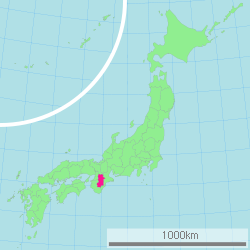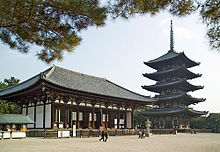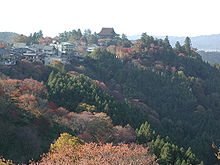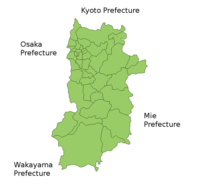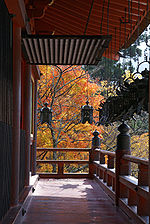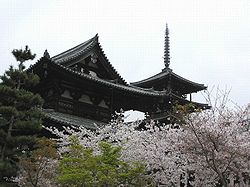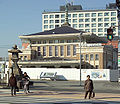- Nara Prefecture
-
Nara Prefecture Japanese transcription(s) – Japanese 奈良県 – Rōmaji Nara-ken 
Symbol of Nara PrefectureCountry Japan Region Kansai Island Honshū Capital Nara Government – Governor Shōgo Arai Area – Total 3,691.09 km2 (1,425.1 sq mi) Area rank 40th Population (March 1, 2011) – Total 1,396,849 – Rank 29th – Density 378.43/km2 (980.1/sq mi) ISO 3166 code JP-29 Districts 7 Municipalities 39 Flower Nara yae zakura
(Prunus verecunda cultivar)Tree Sugi (Cryptomeria japonica) Bird Japanese robin (Erithacus akahige) Website www.pref.nara.jp/english/ Nara Prefecture (奈良県 Nara-ken) is a prefecture in the Kansai region on Honshū Island, Japan.[1] The capital is the city of Nara.[2]
Contents
History
See also: Asuka period and Nara periodThe present-day Nara Prefecture was created in 1887, making it independent of Osaka Prefecture.
Historically, Nara Prefecture was also known as Yamato-no-kuni or Yamato Province.[3]
Up to Nara Period
It is certain that a political force established at the foot of Mount Miwa in the east of Nara Basin, seeking unification of most parts in Japan from the third century until the fourth century, though the process was not well documented. At the dawn of history, Yamato was clearly the political center of Japan.
Ancient capitals of Japan were built on the land of Nara, namely Asuka-kyō, Fujiwara-kyō (694–710) and Heijō-kyō (most of 710–784). The capital cities of Fujiwara and Heijō are believed to have been modeled after Chinese capitals at the time, incorporating grid layout patterns. The royal court also established relations with Sui and then Tang Dynasty China and sent students to the Middle Kingdom to learn high civilization. By 7th century, Nara accepted the many immigrants including refugees of Baekje who had escaped from war disturbances of the southern part of the Korean peninsula. The first high civilization with royal patronage of Buddhism flourished in today's Nara city (710–784 AD).
Nara in the Heian period
In 784, Emperor Kammu decided to relocate the capital to Nagaoka-kyō in Yamashiro Province, followed by another move in 794 to Heian-kyō, marking the start of the Heian period. The temples in Nara remained powerful beyond the move of political capital, thus giving Nara a synonym of Nanto (meaning "South Capital") as opposed to Heian-kyō, situated in the north. Close at the end of Heian period, Taira no Shigehira, a son of Taira no Kiyomori, was ordered by his father to depress the power of mainly Kōfuku-ji and Tōdai-ji, who were backing up an opposition group headed by Prince Mochihito. The movement has led into a collision between the Taira and the Nara temples in 1180, when eventually Kōfuku-ji and Tōdai-ji were set on fire, resulting in the vast loss of its architectures.
Middle age Nara
At the rise of the Minamoto to its ruling seat and the opening of Kamakura Shogunate, Nara enjoyed the support of Minamoto no Yoritomo toward restoration. Kōfuku-ji, being the "home temple" to the Fujiwara since its foundation, not only regained the power it had before but became a de facto regional chief of Yamato Province. With the recovery of Kōfuku-ji and Tōdai-ji, there was a town growing near the two temples.
The Nanboku-chō period, starting in 1336, brought more instability to Nara. As Emperor Go-Daigo chose Yoshino as his base, a power struggle arose in Kōfuku-ji with a group supporting the South and another siding the North court. Likewise, local clans were split into two. Kōfuku-ji recovers its control over the province for a short time at the surrender of the South Court in 1392, while the internal power game of the temple itself opened a way for the local samurai clans to spring up and fight with each other, gradually acquire their own territories, thus diminishing the influence of Kōfuku-ji overall.
The Sengoku, Edo periods and beyond
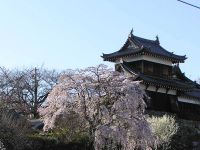 The restored turret of Kōriyama Castle
The restored turret of Kōriyama Castle
Later the whole province of Yamato got drawn into the confusion of the Sengoku period. Tōdai-ji was once again set on fire in 1567, when Matsunaga Hisahide, who was later appointed by Oda Nobunaga to the lord of Yamato Province, fought for supremacy against his former master Miyoshi family. Followed by short appointments of Tsutsui Junkei and Toyotomi Hidenaga by Toyotomi Hideyoshi to the lord, the Tokugawa Shogunate ultimately ruled the city of Nara directly, and most parts of Yamato province with a few feudal lords allocated at Kōriyama, Takatori and other places. With industry and commerce developing in the 18th century, the economy of the province was incorporated into prosperous Osaka, the commercial capital of Japan at the time.
The economic dependency to Osaka characterizes even today's Nara Prefecture, for many inhabitants commute to Osaka to work or study there.
Geography
Nara Prefecture is part of the Kansai, or Kinki, region of Japan, and is located in the middle of the Kii Peninsula on the western half of Honshū. Nara Prefecture is landlocked. It is bordered to the west by Wakayama Prefecture and Osaka Prefecture; on the north by Kyoto Prefecture and on the east by Mie Prefecture. Nara Prefecture is 78.5 km from East to West and 103.6 km from North to South.
The prefecture is covered by mountains and forests for most of its part, leaving only an inhabitable area of 851 km², smallest of the 47 prefectures of Japan. The ratio of inhabitable area over total area is 23%, ranked 43rd nationwide.[4]
Geologically, Nara Prefecture is bisected by the Japan Median Tectonic Line (MTL) running through its territory East-West, along Yoshino River. On the north side is located the so-called Inner Zone, where North-South active faults are shaping the landscape. There is Ikoma Mountains in the north-west forming a border line between Osaka, then the Nara Basin laid out next to it in the east, where the highest population of Nara Prefecture concentrates. Further to the east is the Kasagi Mountains separating the basin from Yamato Highlands. In the south of the MTL, the Outer Zone, is the Kii Mountains. This mountainous area occupies about 60% of the prefecture's land. The Ōmine Mountain Range is in the center of the Kii Mountains running North-South, with steep valleys on its both sides. The 1915 m high tallest mountain of Nara and Kansai, the Mount Hakkyō is in this range. In the west side separating Nara from Wakayama is the Obako Mountain Range, with its 1300 m class mountains. On the east end bordering Mie is the Daikō Mountain Range, including the 1695 m high Mount Ōdaigahara. This wide mountain area is also home to the World Heritage Site collectively inscribed as the "Sacred Sites and Pilgrimage Routes in the Kii Mountain Range" by UNESCO.
Climate
The climate of Nara Prefecture is overall warm, while there are important differences between the north-western basin area and the rest of the prefecture, that is, in the mountains.
In the basin area the climate has an inland characteristics, as represented in the bigger temperature variance within the same day, and the difference of summer and winter temperatures. Winter temperatures average about 3 to 5 °C, and 25 – 28 °C in the summer with highest reaching close to 35 °C. There is not a single year over the last decade (since 1990, up to 2007) with more than 10 days of snowfall recorded by Nara Local Meteorological Observatory.
The climate in the rest of the prefecture are mountainous, and especially in the south, with below −5 °C being the extreme minimum in winter. Heavy rainfall is observed in summer. The annual accumulated rainfall ranges as much as 3000 to 5000 mm, which is among the heaviest in Japan.
Spring and fall are both temperate and beautiful. The mountainous region of Yoshino has been popular both historically and presently for its beautiful cherry blossoms in the spring. In the fall, the southern mountains are equally beautiful with the changing of the oak trees.
Cities
- Nara (capital)
- Sakurai
- Tenri
- Uda
- Yamatokōriyama
- Yamatotakada
Towns and villages
Towns and villages in each district:
Mergers
Main article: List of mergers in Nara PrefectureDemographics
Population by districts[5] District Area Size
(km²)Population Density
per km²Yamato flat inland plain 837.27 1,282 1,531 (Share in %) 22.7% 89.7% Yamato highland 506.89 56 110 (Share in %) 13.7% 3.9% Gojō, Yoshino 2,346.84 92 39 (Share in %) 63.6% 6.4% Total Prefecture 3,691.09 1,430 387 (Share in %) 100.0% 100.0% According to the 2005 Census of Japan, Nara Prefecture has a population of 1,421,310, which is a decrease of 1.5%, since the year 2000.[6]
The decline continued in 2006, with another decrease of 4,987 people compared to 2005. This includes a natural decrease from previous year of 288 people (11,404 births minus 11,692 deaths) and a decrease due to net domestic migration of 4,627 people outbound from the prefecture, and a decrease of 72 registered foreigners. Net domestic migration has turned into a continuous outbound trend since 1998. The largest destinations of migration in 2005 were the prefectures of Kyoto, Tokyo and Hyōgo, with respectively a net of 1,130, 982 and 451 people moving over. The largest inbound migration was from Niigata Prefecture, contributing to a net increase of 39 people. 13.7% of its population were reported as under 15, 65.9% between 15 and 64, and 20.4% were 65 or older. Females made up approximately 52.5% of the population.[7]
As of 2004, the average density of the prefecture is 387 people per km². By districts,[8] the so-called Yamato flat inland plain holds as much as about 90% of total population within the approximately 23% size of area in the north-west, including the Nara Basin, representing a density of 1,531 people per km². To the contrast, the combined district Gojō and Yoshino District occupies almost 64% of the land, while only 6% of people lives there, resulting in a density of 39 people km².
Nara prefecture had the highest rate in Japan of people commuting outbound for work, at 30.9% in 2000. A similar tendency is seen in prefecutes as Saitama, Chiba and Kanagawa, all three of them having over 20% of people commuting for other prefectures.[4]
Politics
- A governor and members of prefectural assembly is elected by citizens in accordance with the Local Autonomy Law.
- As of 2007, there are 44 seats in the Nara Prefectural Assembly, voted through 16 electoral blocks.
- There was a clear tendency seen through the results of Lower House election in 2005, that the younger generation executes its voting right much less compared to the older. Only 48.8% of citizens age 20–29 voted, whereas all older generations (grouped by decades) votes more than its younger, reaching the highest voting rate of 86.3% at ages 60–69. The only exception was the 72.1% voting right executed by citizens of 70 or older. The overall average of the prefecture who voted was yet higher, at 70.3%, than that of nationwide average, 67.5%.[9]
Economy
The 2004 total gross prefecture product (GPP) for Nara was ¥3.8 trillion, an 0.1% growth over previous year. The per capita income was ¥2.6 million, which is a 1.3% decrease from previous year. The 2004 total gross prefecture product (GPP) for Nara was ¥3.8 trillion, an 0.1% growth over previous year. Manufacturing has the biggest share in the GPP of Nara with 20.2% of share, followed by services (19.1%) and real estates (16.3%). The share of agriculture including forestry and fishery was a mere 1.0%, only above mining, which is quasi-inexistent in Nara.[10]
- Tourism is treated by the prefectural government as one of the most important features of Nara, because of its natural beauty and historical significance.
- Nara is famed for its Kaki persimmon. Strawberry and tea are some other popular products of the prefecture, while rice and vegetables, including spinach, tomato, eggplants and others are the dominant in terms of amount of production.
- Nara is a center for the production of instruments used in conducting traditional Japanese artforms. Brush and ink (sumi) are the best known products from Nara for calligraphy. Wooden or bamboo instruments, especially from Takayama area (in Ikoma city) are famous products for tea ceremony.
- Goldfish from Yamatokoriyama in Nara have been a traditional aquacultural product since the 18th century.
- Due to its rich history, Nara is also the location of many archeological digs, with many famous ones being located in the village of Asuka.
Culture
Because of its background, the better part of Nara's culture can only be described through learning the history of Japan, notably in Nara Period.
Nara is currently in its preparation to celebrate the 1300th anniversary of the opening of Heijō Palace.
Education
Universities
- Nara Women's University
- Nara Medical University
- Nara University of Education
- Nara University
- Nara Prefectural University
- Nara Sangyo University (Nara Industrial University)
- Nara Institute of Science and Technology
- Kio University
- Tezukayama University
- Tenri University
Sports
The sports teams listed below are based in Nara.
Tourism
Many Jinja (Shinto shrines) and Buddhist temples, and kofun exist in Nara Prefecture, and it is a centre for tourism. Moreover, many world heritage sites, such as the temple Tōdai-ji and Kasuga Shrine, exist in the capital city of Nara.
World Heritage sites
Buddhist Monuments in the Hōryū-ji Area
Hōryū-ji 法隆寺 Hokki-ji (Hōki-ji) 法起寺 Historic Monuments of Ancient Nara
Tōdai-ji 東大寺 Kōfuku-ji 興福寺 Kasuga Shrine 春日大社 Gangō-ji 元興寺 Yakushi-ji 薬師寺 Tōshōdai-ji 唐招提寺 Heijo Palace remains 平城宮跡 Shōsō-in 正倉院 Sacred Sites and Pilgrimage Routes in the Kii Mountain Range
Area Mt. Yoshino Kinpusen-ji Yoshino Mikumari Shrine Kinpu Shrine Yoshimizu Shrine Mount Omine Ominesan-ji Buddhist temples
Asuka-dera 飛鳥寺 Hase-dera 長谷寺 Hōrin-ji 法輪寺 Ōminesan Ryusen-ji 大峯山龍泉寺 Saidai-ji 西大寺 Southern Hokke-ji 南法華寺 Chūgū-ji 中宮寺 Shinto shrines
Isonokami Shrine 石上神宮 Kashihara Shrine 橿原神宮 Danzan Shrine 談山神社 Ōmiwa Shrine 大神神社 Ōyamato Shrine 大和神社 Kofun and heritage
Ishibutai Tomb 石舞台古墳 Kitora Tomb キトラ古墳 Takamatsuzuka Tomb 高松塚古墳 Hashihaka Tomb 箸墓古墳 Umami Kofun Group 馬見古墳群 Sakafuneishi Heritage 酒船石遺跡 Hot springs
Dorogawa 洞川温泉 Shionoha 入之波温泉 Kamiyu 上湯温泉 Totsukawa 十津川温泉 Mountains
Mount Amanokagu* 天香具山 Mount Miminashi* 耳成山 Mount Unebi* 畝傍山 Mount Wakakusa 若草山 * "Three Mountains of Yamato" Other attractions
Nara Park 奈良公園 Yoshino-Kumano National Park 吉野熊野国立公園 Kongō Ikoma Kisen National Park 金剛生駒紀泉国定公園  World Heritage Sites in Nara
World Heritage Sites in Nara
Miscellaneous topics
Gallery
-
Akishino-dera, a Buddhist temple in Nara
Transportation
Railroad
- JR West
- Yamatoji Line
- Kansai Line
- Manyo Mahoroba Line
- Wakayama Line
- Kintetsu
Bus
'Departure from Nara and Tenri
- Shinjuku of Tokyo
- Tokyo Station
- Yokohama
- Tokyo Disneyland in Urayasu
- Makuhari of Chiba
- Nagoya
- Osaka International Airport
- Kansai International Airport
'Departure from Yamato Yagi and Gose'
Road
'Expressway and Toll Road'
- Nishi-Meihan Expressway
- Meihan Road
- Keinawa Expressway
- Second Hanna(Osaka-Nara) Road
- South Hanna Road
'National Highways'
- Route 24
- Route 25 (Osaka-Tenri-Nabari-Yokkaichi)
- Route 163
- Route 165
- Route 166
- Route 168 (Hirakata-Ikoma-Kashiba-Gojo-Totsukawa-Shingu)
- Route 169 (Nara-Tenri-Oyodo-Yoshino-Shingu)
- Route 308
- Route 309
- Route 310
- Route 311
- Route 368
- Route 369
- Route 370
- Route 371
- Route 422
- Route 425
Notes
- ^ Nussbaum, Louis-Frédéric. (2005). "Nara-ken" in Japan Encyclopedia, p. 699 at Google Books; "Kansai" at p. 477 at Google Books.
- ^ Nussbaum, "Nara" at p. 698 at Google Books.
- ^ Nussbaum, "Yamato" at p. 1046 at Google Books.
- ^ a b "奈良県統計情報 "100の指標" ("100 Indices of Nara" by Nara Statistics Division, Nara Prefecture)" (in Japanese). http://www.pref.nara.jp/pro/toukei/index.htm. Retrieved 2007-03-17.
- ^ Whitepaper on Ecology (Japanese). Prefecture of Nara. Retrieved on April 10, 2007.
- ^ "Population Census 2005" (in Japanese). Archived from the original on 2008-04-15. http://web.archive.org/web/20080415201002/http://www.pref.nara.jp/pro/toukei/chousa_shoukai/h17kokusei/index.html. Retrieved 2007-04-10. (Including official amendment of March 5, 2007)
- ^ "Population Statistics of Nara Prefecture 2006" (in Japanese). Archived from the original on 2008-01-18. http://web.archive.org/web/20080118064416/http://www.pref.nara.jp/pro/toukei/group/jinkou/jinkou.htm. Retrieved 2007-04-10.
- ^ Defined by Nara Prefecture for the convenience of statistical analysis. See "Population of each district" for 2005 figures.
- ^ "tōhyō ritsu no sui'i (投票率の推移 Evolution in voting rate, Nara Prefecture" (in Japanese). Archived from the original on 2008-06-12. http://web.archive.org/web/20080612055657/http://www.pref.nara.jp/senkan/contents/tohyoritsu.htm. Retrieved 2007-04-10.
- ^ "奈良県民経済計算 (Nara kenmin keizai keisan Nara Prefectural Economy)". Nara Prefecture. 2002-04-09. Archived from the original on 2007-03-14. http://web.archive.org/web/20070314160140/http://www.pref.nara.jp/pro/toukei/group/kikaku/kenmin.htm. Retrieved 2007-03-28. English page with much less details are available here.
References
- Nussbaum, Louis-Frédéric and Käthe Roth. (2005). Japan encyclopedia. Cambridge: Harvard University Press. 10-ISBN 0-674-01753-6; 13-ISBN 978-0-674-01753-5; OCLC 58053128
External links
- Official Nara Prefecture homepage
- Buddhist Monuments in the Horyu-ji Area (UNESCO)
- Historic Monuments of Ancient Nara (UNESCO)
- Sacred Sites and Pilgrimage Routes in the Kii Mountain Range (UNESCO)
- Map of Nara City
- Photos of Nara's temples & shrines
- Nara Tourist Information Center
- Commemorative Events of the 1300th Anniversary of Nara Heijo-kyo Capital
 Nara Prefecture
Nara PrefectureCities 
Ikoma District Kitakatsuragi District Shiki District Takaichi District Uda District Yamabe District Yoshino District Regions and administrative divisions of  Japan
JapanRegions 
Prefectures Hokkaido Tōhoku Kantō Chūbu Kansai Chūgoku Shikoku Kyushu
Wikimedia Foundation. 2010.

